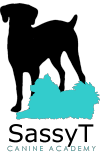Terra, at 10 weeks old. DEFINITELY a puppy alligator! :)
Do you have a Lab-a-Gator?
Or a Doodle-Gator?
Rest assured, there is no new companion animal showing up in the pet stores that has scales combined with cute floppy puppy ears and requires a kiddie pool instead of a dog crate.
But! This does describe a very trying time in every puppy’s development. Armed with super-sharp milk teeth, this stage of development is when their curious and exploratory nature includes putting their mouth on everything: your hand, your shoe laces, the leash, your scarf, your sleeve… the list goes on and on! We are not talking about chewing objects like table legs, we are talking about puppy mouthing!
Why do puppies do this?
Puppy’s mouth each other during a very special time in their development.
This developmental stage is designed to teach them how to be gentle with the sharp weapons that will eventually develop in their eventually very strong jaws.
As adults, they will have a bite strength three times that of a human, and they need to know how to be gentle with these weapons, during interactions with both humans and other dogs. The easiest (and sometimes the only) way dogs can learn this is during this special time in their development: through their interactions with other puppies, other adult dogs, and the lucky humans they live with!
Puppies play with their littermates by mouthing, biting and chewing on each other.
Throughout this play, the puppies receive feedback about their behavior, whether appropriate or not. Gentle play continues without interruption, while a puppy who is too rough will end up with few or no playmates. This feedback motivates puppies to mouth and play more gently in order to keep their playmates.
So how do we replicate this, in a household with only one dog and a few humans? Our main goal is to slowly get rid of inappropriate mouthing over time, by providing appropriate mouthy-outlets, coaching family members, and making sure to teach a few self-control exercises along the way.
It's a two-stage process:
Stage 1 teaches puppy to be gentle.
Stage 2 teaches puppy no teeth at all on human skin. Stage 2 only starts when puppy starts getting adult teeth.
Rules To Live By
- During Stage 1: Give your puppy a free pass for anything that does not hurt. It’s important that they learn to identify gentle. Allow exploratory mouthing, and offer a chew toy as an alternative.
- If it DOES hurt: say ‘Ouch!’ and remove all fun things for 20 seconds, including petting, talking, eye contact, playtime, laptime, etc.
- During Stage 2: Act as though it hurts every time she uses her mouth on skin.
Set the Puppy Up for Success
- Be proactive during rowdy times: early morning and night. Give extra walks, playdates, training, or fetch/tug games to provide appropriate outlets for this energy.
- Make sure the puppy has 3-5 dog-play opportunities a week. Dogs learn more quickly from other dogs!
- Encourage children/family members to move arms and hands slowly and calmly when around the puppy. Children MUST play with a toy with the puppy; no roughhousing or wrestling, since hands are not playthings.
- Offer a very large variety (15-20) of chew toys and play toys, of various and novel textures. Keep one in your pocket! Anytime you are petting or interacting with your puppy, offer a substitute toy instead of your hand.
Training Exercises will Help
- Hand feed as many meals as possible, encouraging gentle food-taking.
- Teach “touch” and practice twice daily for 5 minutes.
- Teach “tug” “give” and “wait” so you can play a controlled puppy tug game twice daily for 10 minutes.
- Enroll in a group puppy class, to socialize your puppy and provide an appropriate outlet for all that mouthing. www.teachrover.com


